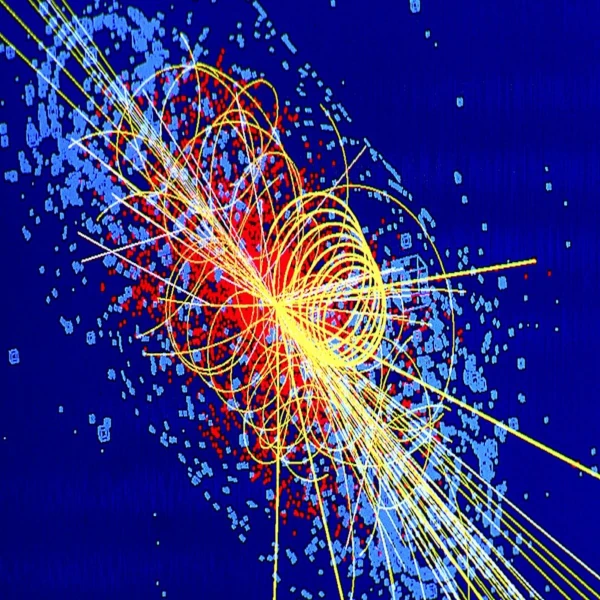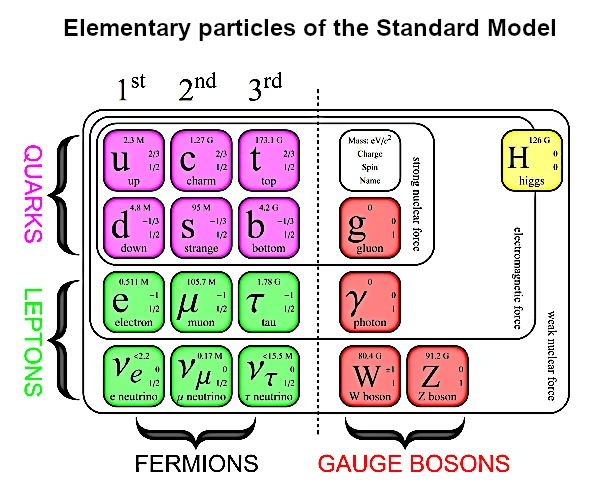
The Standard Model is the quantum theory that describes all known elementary particles and their fundamental interactions (except gravity). It is based on the gauge symmetry \(\text{SU(3)}_C \times \text{SU(2)}_L \times \text{U(1)}_Y\), where each factor corresponds to an interaction: the strong interaction, the weak interaction, and electromagnetism.
It includes:
This highly predictive theoretical framework has been confirmed by thousands of experiments since the 1970s. However, it does not include gravity, dark matter, or dark energy, and therefore needs to be extended. The Higgs field is an essential ingredient in this coherent construction, as it allows fermions and \(W\)/\(Z\) bosons to acquire mass.
The concept of a gauge field is central to modern particle physics. It arises from a principle of local symmetry: the idea that physical laws must remain invariant under certain local transformations. This principle naturally imposes the existence of mediating fields to ensure the coherence of the theory.
Specifically, when we impose a local invariance (for example, under the U(1) transformation for electromagnetism), the mathematical formalism forces us to introduce a new field, called a gauge field. This field compensates for local variations and physically translates into a force:
These fields are described by non-Abelian gauge theories (for SU(2) and SU(3)), where the gauge fields also interact with each other. The formalism is expressed using curvature tensors (or field tensors), gauge connections, and invariant Lagrangians, as in the famous Yang-Mills formula.
Without these gauge fields, it would be impossible to formulate a coherent theory of interactions. But all these fields presuppose that the associated particles are massless, which poses a problem for the weak interaction. This is where the Higgs field comes in, the only one capable of generating mass without breaking the fundamental internal symmetries.

The Higgs boson is the quantum manifestation of a fundamental field called the Higgs field. This field, omnipresent in the Universe, interacts with elementary particles via a mechanism discovered in the 1960s by several physicists, including Peter Higgs. Unlike other fundamental forces, it is not a particle but a scalar field that is responsible for the mass of particles. When a particle passes through this field, it undergoes a form of "resistance," similar to quantum viscosity, which gives it its mass.
In the language of the Standard Model, this interaction is mathematically translated by a spontaneous breaking of electroweak symmetry. This allows the \(W^{\pm}\) boson and the \(Z^0\) boson to have mass, while leaving the photon massless. This asymmetry observed in nature—some particles having mass, others not—directly results from the coupling of these particles to the Higgs field.
On July 4, 2012, the ATLAS and CMS experiments at the Large Hadron Collider (LHC) at CERN announced the detection of a new particle, consistent with the Higgs boson. This discovery represents the culmination of nearly half a century of theoretical and experimental research. The boson was observed via its decay modes: mainly into two photons (\(H \rightarrow \gamma\gamma\)) or into pairs of \(Z\) or \(W\) bosons, at a mass of about 125 GeV/\(c^2\).
This discovery confirms that the Higgs field indeed exists, thus validating the proposed mechanism to explain the generation of masses. However, this confirmation also opens new fundamental questions: why is the Higgs boson so light? Is the Higgs field linked to deeper physics such as supersymmetry or extra dimensions?
In the Standard Model of particle physics, all interactions (electromagnetic, weak, strong) are described by gauge fields. Without the Higgs field, all gauge particles would be massless, and the coherence of the model would be broken. The presence of the Higgs field preserves the renormalizability of the model while explaining the diversity of masses observed in nature.
The Higgs boson is literally the "keystone" of the Standard Model: without it, the equations lose their predictive power. Nevertheless, the Standard Model does not describe everything. It ignores gravity, dark matter, and dark energy. It remains incomplete, and the Higgs boson could be a gateway to physics beyond the Standard Model.